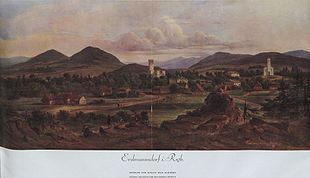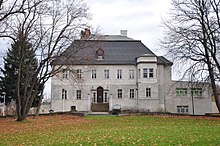Mysłakowice
| Mysłakowice | ||
|---|---|---|

|
|
|
| Basic data | ||
| State : | Poland | |
| Voivodeship : | Lower Silesia | |
| Powiat : | Jelenia Gora | |
| Geographic location : | 50 ° 51 ' N , 15 ° 47' E | |
| Height : | 280 m npm | |
| Residents : | 4500 | |
| Postal code : | 58-533 | |
| Telephone code : | (+48) 75 | |
| License plate : | DJE | |
| Economy and Transport | ||
| Street : | Jelenia Góra - Kowary | |
| Next international airport : | Wroclaw | |
| Gmina | ||
| Gminatype: | Rural community | |
| Gmina structure: | 8 school offices | |
| Surface: | 88.75 km² | |
| Residents: | 10,160 (Jun. 30, 2019) |
|
| Population density : | 114 inhabitants / km² | |
| Community number ( GUS ): | 0206072 | |
| Administration (as of 2013) | ||
| Mayor : | Zdzisław Pietrowski | |
| Address: | ul.Szkolna 5 58-533 Mysłakowice |
|
| Website : | www.myslakowice.pl | |
Mysłakowice [ mɨswakɔˈvʲitsɛ ] ( Ger . Zillerthal-Erdmannsdorf ) is a place in southwestern Poland and the seat of the rural community of the same name. It is located in the Jeleniogórski district of the Lower Silesian Voivodeship between the Giant Mountains and the Landeshuter Ridge , belongs to the Neisse Euroregion and has numerous guest beds.
geography

Mysłakowice is located in the eastern part of the Hirschberg Valley on the rivers Lomnitz (Polish: Łomnica ) and Bober (Bóbr) , about 8 km southeast of Hirschberg and 7 km north of Krummhübel . The municipal area extends largely along these flowing waters and in the area of the Landeshuter Ridge to the east , to which the Falkenberge ( Sokole Góry ) also belong. At the foot of the Falkenberge and the Landeshuter Ridge are the suburbs of Karpniki (Fischbach) and Bukowiec (Buchwald) , from which some of the most beautiful views of the nearby Giant Mountains are offered.
The Giant Mountains begin immediately south of Erdmannsdorf (Mysłakowice) in the neighboring municipality of Giersdorf ( Podgórzyn ). There are regular bus connections to Hirschberg (Jelenia Góra) , Krummhübel (Karpacz) and the surrounding villages.
history

Erdmannsdorf was first mentioned in a document in 1305. During the early modern period it was owned by the von Reibnitz family .
From 1838 Protestant exiles from Tyrol ( Zillertal inclinants ) settled in Erdmannsdorf , to whom the Prussian King Friedrich Wilhelm III. , at the intercession of Countess Friederike von Reden , granted refuge. Since they were mountain dwellers, they settled in the Giant Mountains, the highest mountains in Prussia . Many of the immigrants came from the Zillertal , which led to the name of the place being changed to Zillerthal-Erdmannsdorf in the course of the 19th century .
During the Second World War , a satellite camp of the Groß-Rosen concentration camp was located here . After the end of the war, placed under the administration of the People's Republic of Poland , the place was renamed Turońsk in 1945 and Mysłakowice in December 1946, as well as the expulsion of the inhabitants and repopulation by Poland until 1946 .
1975 to 1998 Mysłakowice belonged to the Jelenia Góra Voivodeship, which in 1999 became part of the new Lower Silesian Voivodeship.
Attractions
Churches, country estates and castles in all parts of the village as well as the landscape accessible by numerous hiking trails are worth seeing, including:
Parish Church of the Sacred Heart
The Catholic parish church Herz Jesu ( Kościół pw. Najświętszego Serca Pana Jezusa , also Kościół Królów Pruskich = "Church of the Prussian Kings") on the edge of the palace garden, designed by Karl Friedrich Schinkel as a palace church, then from 1836 to 1838 also as an evangelical parish church for the Zillertal religious refugees built. During the renovation in 1858, a portico with excavated ancient Roman columns from Pompeii was added to the entrance , which Joseph Bonaparte , the temporary King of Naples, Friedrich Wilhelm III. had given. The organ was made in 1840 by the Hirschberg organ builder Carl Friedrich Ferdinand Buckow .
Erdmannsdorf Castle

Erdmannsdorf Castle was a summer residence of the Hohenzollern family from 1832 to 1909 . Its predecessor, dating from the early 18th century, was converted in 1751 by Maximilian Leopold von Reibnitz into a two-storey baroque residence with a three-wing floor plan. After several changes of ownership, Field Marshal August Neidhardt von Gneisenau acquired the property in 1816 in exchange for another of his goods. After Gneisenau's death in 1831, Prussia's King Friedrich Wilhelm III. the castle for 136,000 thalers , as he had come to know and appreciate the Hirschberg Valley through visits to Fischbach Castle , which his brother Prince Wilhelm had acquired in 1822. In the following years, the Erdmannsdorf Castle was rebuilt by Karl Friedrich Schinkel , who also built the church in the castle park, on the edge of the sight line from the castle to the Giant Mountains, while the royal court gardener Peter Joseph Lenné designed planting plans for the castle park. Erdmannsdorf became the preferred summer retreat of the king and his second wife, the princess of Liegnitz . In 1839 the king also acquired the nearby Schildau Castle for his daughter Luise , princess of the Netherlands. Erdmannsdorf Castle owes its current shape mainly to the renovations in the Tudor Gothic style under King Friedrich Wilhelm IV. , Whose ideas were realized by Friedrich August Stüler from 1840 onwards. Next to Erdmannsdorf Castle is the "Villa Liegnitz", which was built in 1842 for the widow of Friedrich Wilhelm III. who had previously sold the castle to her stepson. Today the castle serves as a school, the park with the ponds has been preserved in its basic features, but the optical orientation towards the Giant Mountains has grown over.
Erdmannsdorf Castle Park is a member of the Garden Culture Trail on both sides of the Neisse . This improves the possibilities of care ( park seminars ) and the prospects for funding and tourist development.
Tyrolean court
The residential building at ul. Starowiejska 14 is the so-called Tiroler Hof . It is one of several houses that were built by religious refugees in the Tyrolean style in the 19th century and have been preserved in Mysłakowice to this day. After renovation measures, the building was reopened in 1998 as a Tyrolean restaurant. Its new owners are the federal state of Tyrol ( Austria ) and the six Tyrolean communities of origin of the exiles .
Buchwald Castle

Buchwald Castle (Bukowiec) was built for the von Zedlitz family in the second half of the 16th century and was expanded by the von Reibnitz family around 1744 . In 1785 it was bought by the future Prussian Mining Minister Friedrich Wilhelm Graf von Reden (1752–1815); Together with his wife Friederike , he created an important landscape park in the spirit of sensitivity and provided the surrounding hills and water with numerous staffage structures. They made Buchwald Castle an intellectual and spiritual center of the Silesian nobility. Friederike's niece Marie Karoline Baroness von Rotenhan became heir, and her descendants owned it until 1945.
The castle park is a member of the garden culture trail on both sides of the Neisse . This improves the possibilities of care ( park seminars ) and the prospects for funding and tourist development.
local community
The rural community of Mysłakowice consists of the eponymous main town and the following districts:
Partnerships
literature
- Theodor Donat, Erdmannsdorf. Its sights and history , Hirschberg 1887
- The valley of castles and gardens. The Hirschberg Valley in Silesia - a common cultural heritage , society for interregional cultural exchange e. V., Berlin and Jelenia Góra 2002
- Arne Franke, Erdmannsdorf. Castle, park, church, Tyrolean houses, Swiss house | Mysłakowice. Zamek, Kośiół Park, Domy tyrolskie, Dom szwajcarski. German Cultural Forum for Eastern Europe eV, 2005, 66 pages, bilingual German-Polish, ISBN 978-3-936168-32-7
- Helga and Horst Bast: The families of the Protestants who emigrated from the Zillertal in 1837 - their ancestors and descendants, the emigration, the path, the settlement, their houses and their life in the Hirschberg Valley. Cardamina Verlag, May 2012, ISBN 978-3-86424-044-7
Web links
- Website of the municipality - information and pictures (Polish, English, German)
- www.sudety.wroclaw.pl/index/miejscowosci/ID,108 - Mysłakowice: information (Polish)
- Lots of historical information on all parts of the community ( Memento from September 27, 2007 in the Internet Archive ) (German)
- Material on Erdmannsdorf in the Duncker Collection of the Central and State Library Berlin (PDF; 230 k; 236 kB)
- Schlosspark Buchwald on the homepage of the garden culture path on both sides of the Neisse
- Schlosspark Erdmannsdorf on the homepage of the garden culture path on both sides of the Neisse
Individual evidence
- ↑ population. Size and Structure by Territorial Division. As of June 30, 2019. Główny Urząd Statystyczny (GUS) (PDF files; 0.99 MiB), accessed December 24, 2019 .
- ^ Foundation of German Culture in Eastern Europe / Cultural Foundation of the German Expellees , The Riesengebirgs-Älpler - The Resettlement of Tyrolean Protestants to Lower Silesia , November 10, 2009
- ↑ Wolfgang Benz , Barbara Distel (ed.): The place of terror . History of the National Socialist Concentration Camps. Verlag CH Beck, Munich (9 volumes; 2005–2009).
- ↑ cykl Gminy polskie - gmina Mysłakowice - historia gminy w latach
- ^ Erdmannsdorf Castle (accessed November 2, 2017)
- ↑ Homepage garden culture path on both sides of the Neisse, members and cooperation partners , accessed on June 4, 2018
- ↑ Homepage garden culture path on both sides of the Neisse, members and cooperation partners , accessed on June 4, 2018




